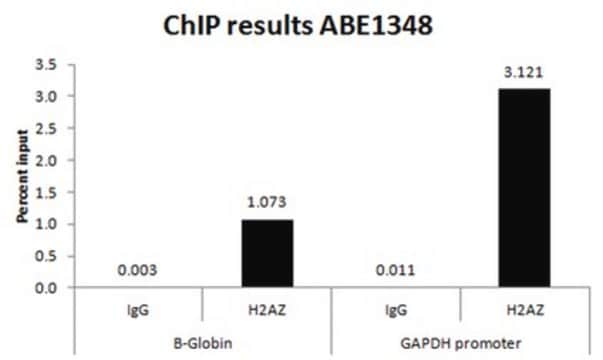ABE569
Anti-monoubiquitin H2A Antibody (Lys119)
from rabbit, purified by affinity chromatography
Synonim(y):
H2AK119ub1, Histone H2A.1, Histone H2A.2, H2A2, h2aUb
About This Item
Polecane produkty
pochodzenie biologiczne
rabbit
Poziom jakości
forma przeciwciała
affinity isolated antibody
rodzaj przeciwciała
primary antibodies
klon
polyclonal
oczyszczone przez
affinity chromatography
reaktywność gatunkowa
human, mouse
metody
ChIP: suitable
immunocytochemistry: suitable
immunoprecipitation (IP): suitable
western blot: suitable
numer dostępu NCBI
numer dostępu UniProt
Warunki transportu
wet ice
docelowa modyfikacja potranslacyjna
unmodified
informacje o genach
rat ... Hist2H2Aa2(690131)
Opis ogólny
Immunogen
Zastosowanie
Epigenetics & Nuclear Function
Histones
Immunoprecipitation Analysis: A representative lot from an independent laboratory immunoprecipitated monoubiquitin H2A in mouse Embryonic Stem cell lysate (Farcas, A. M. et al. (2012). Elife [Epub ahead of print].).
Chromatin Immunoprecipitation Analysis: A representative lot from an independent laboratory immunoprecipitated monoubiquitin H2A in mouse Embryonic Stem cell lysate (Farcas, A. M. et al. (2012). Elife [Epub ahead of print].).
Jakość
Western Blotting Analysis: A 1:1,000 dilution from a representative lot detected monoubiquitin H2A (Lys119) in 10 µg of HeLa acid extract.
Opis wartości docelowych
Postać fizyczna
Przechowywanie i stabilność
Note: Variability in freezer temperatures below -20°C may cause glycerol containing solutions to become frozen during storage.
Komentarz do analizy
HeLa acid extract
Oświadczenie o zrzeczeniu się odpowiedzialności
Not finding the right product?
Try our Narzędzie selektora produktów.
Kod klasy składowania
12 - Non Combustible Liquids
Klasa zagrożenia wodnego (WGK)
WGK 1
Temperatura zapłonu (°F)
Not applicable
Temperatura zapłonu (°C)
Not applicable
Certyfikaty analizy (CoA)
Poszukaj Certyfikaty analizy (CoA), wpisując numer partii/serii produktów. Numery serii i partii można znaleźć na etykiecie produktu po słowach „seria” lub „partia”.
Masz już ten produkt?
Dokumenty związane z niedawno zakupionymi produktami zostały zamieszczone w Bibliotece dokumentów.
Nasz zespół naukowców ma doświadczenie we wszystkich obszarach badań, w tym w naukach przyrodniczych, materiałoznawstwie, syntezie chemicznej, chromatografii, analityce i wielu innych dziedzinach.
Skontaktuj się z zespołem ds. pomocy technicznej







